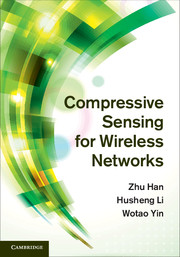8 - Positioning
from Part II - CS-Based Wireless Communication
Published online by Cambridge University Press: 05 June 2013
Summary
Introduction to positioning
In this chapter, we discuss the application of CS in the task of positioning. It is easy to imagine that there are many applications of geographical positioning. For example, in a battlefield, it is very important to know the location of a soldier or a tank. In cellular networks, the location of the mobile user can be used for Emergency-911 services. For goods and item tracking, it is of key importance to track their locations. The precision of positions also ranges from subcentimeters (e.g., robotic surgery) to tens of meters (e.g., bus information).
Several classifications of positioning technologies are given below [338]:
Classified by signaling scheme: In positioning, the target needs to send out signals to base stations or receive signals from base stations in order to determine the target's position. Essentially, the signal needs to be wireless. Radio-frequency (RF), infrared or optical signals can be used.
Classified by RF waveforms: Various RF signals can be used for positioning, such as UWB, CDMA and OFDM.
Classified by positioning-related metrics: The metrics include time of arrival (TOA), time difference of arrival (TDOA), angle of arrival (AOA) and received signal strength (RSS).
Classified by positioning algorithm: When triangulation-based algorithms are used, the positioning is obtained from the intersections of lines, based on metrics such as AOA. In trilateration-based algorithms, the position is obtained from the intersections of circles, based on metrics such as TDOA or TOA. In fingerprinting-based (also called pattern-matching) algorithms, a training period will be spent to establish a mapping between the location and the received signal fingerprinting (or pattern).
- Type
- Chapter
- Information
- Compressive Sensing for Wireless Networks , pp. 193 - 213Publisher: Cambridge University PressPrint publication year: 2013



